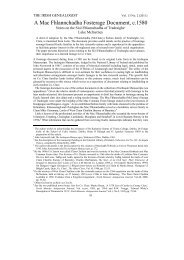Report Cover Vol I - Clare County Library
Report Cover Vol I - Clare County Library
Report Cover Vol I - Clare County Library
You also want an ePaper? Increase the reach of your titles
YUMPU automatically turns print PDFs into web optimized ePapers that Google loves.
The <strong>County</strong> <strong>Clare</strong> Wetlands Survey Patrick Crushell & Peter Foss 2008<br />
___________________________________________________________<br />
Dystrophic lakes<br />
Natural dystrophic lakes<br />
are an Annex 1 habitat<br />
under the EU Habitats<br />
Directive.<br />
Natural lakes and ponds<br />
that are highly acidic (pH<br />
range 3.5-5.5), base-poor<br />
and low in nutrients, and<br />
where the water is brown<br />
in colour owing to inputs of<br />
humic and other acids from<br />
peat.<br />
These lakes are important habitats for insect life.<br />
They are usually associated<br />
with blanket bogs, mainly<br />
the lowland type, raised<br />
bogs, cutover bogs and wet<br />
heathland areas and are<br />
characterised by peaty<br />
rather than rocky margins<br />
and substrata. The<br />
transition from bog to open<br />
water is often abrupt.<br />
The principal threats to natural dystrophic lakes and ponds are peat cutting, overgrazing and afforestation of<br />
peatland habitats.<br />
Relatively common in upland blanket bog areas throughout the county such as within the Lough Atorick Bogs<br />
NHA.<br />
Acid oligotrophic lakes<br />
Annex 1 habitat under the EU Habitats Directive.<br />
Lakes and ponds that are low in nutrients,<br />
base-poor and acidic. Most acid oligotrophic lakes<br />
are associated with areas of acidic bedrock and<br />
many have rocky margins. The substrate in shallow<br />
water is either rock, organic lake sediment, or<br />
coarse mineral material (sand and gravel). Water is<br />
often brownish in colour as a result of inputs from<br />
peaty soils or bogs in the catchments. These lakes<br />
support communities of submerged and floating<br />
aquatic plants.<br />
These lakes are important habitats for insect life.<br />
The principal threats to acid oligotrophic lakes<br />
include nutrient enrichment arising from<br />
agricultural practices such as overgrazing and<br />
excessive fertilisation, as well as afforestation, and<br />
waste water from housing developments in rural<br />
areas. Lakes may also be negatively affected by<br />
the introduction of invasive alien species, and their<br />
utilization for an increasing number of sport and<br />
leisure activities.<br />
This habitat type is relatively common in areas with<br />
a non-calcareous bedrock. An example is Doo<br />
Lough in West <strong>Clare</strong>.<br />
17
















